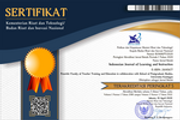THE DEVELOPMENT OF THE IDENTIFICATION KEY CIRCLE MEDIA FOR THE SKILLS OF CLASSIFYING ANIMALS AND STUDENTS’ UNDERSTANDING OF CONCEPTS
Abstract
This research is motivated by the low skill of classifying animals and the low understanding of students' concepts. Preliminary data show that out of 10 groups only 2 groups are skilled in classifying animals. Therefore, this research was conducted to improve the skills of classifying animals and understanding concepts by using the identification key circle media. The research subjects were 36 students of class VII A of SMPN 4 Kuningan. The research data was obtained from the observation of the students' skills in classifying animals and the concept understanding test. Based on the results of the study, it was found that the skill in classifying animals had increased through the Wilcoxon test, the statistical value of the asymp value was obtained. Sig of 0.01. The working hypothesis will be accepted if the value of asymp.sig < , and the value of = 0.05, because the value of asymp.sig = 0.01 <0.05 then Ha is accepted, and an increase in students' understanding of concepts from the final data analysis shows that obtained based on the Independent sample test output table in the equal variances assumed section, the Sig value is known. (2-tailed) of 0.00 < 0.005, so as for decision making in the independent sample t-test, it can be concluded that Ho is rejected and Ha is accepted. Thus, it can be concluded that the identification key circle media can improve students' skills in classifying animals and understanding draft.
Keywords: Key circle media identification; animal classification skills; student concept understanding.
Full Text:
PDFReferences
Anđić, B., Cvijetićanin, S., Maričić, M., and Stešević, D. (2019). The contribution of dichotomous keys to the quality of biological-botanical knowledge of eighth grade students. Journal of Biological Education, 53(3), pp. 310-326.
Cepeda, D., Martin, D., Britayev, T.A.A., Al-Aidaroos, M., and Lattig, P. (2017). Haplosyllis (Annelida: Syllidae) from Saudi Arabian Red Sea, with the description of a new endosymbiotic species and a dichotomous key for the Indo-Pacific species. Marine Biodiversity, 47(4), pp. 1123-1129.
Gintings, A. (2014). Esensi Praktis Belajar & Pembelajaran. Bandung: Humaniora.
Hernandez-Matias, L., Laureano-Torres, F., Washington, A.V., Perez-Donato, L., Calzada-Jorge, N., Borrero, M., Roman, P.L., and Mendoza, S. (2019). An exploratory study comparing students’ science identity perceptions derived from a hands-on research and nonresearch-based summer learning experience. Biochemistry and Molecular Biology Education, 48, pp. 134-142.
Papilaya, P. M. (2020). Field trips strategies and keys to determination on discovery learning in lower-plants botany. Journal of Southwest Jiaotong University, 55(4), 1-12.
Purnamasari, H. (2012). Kunci determinasi dan flashcard sebagai media pembelajaran Inkuiri klasifikasi makhluk hidup SMP. Ennes Science Education Journal. USEJ 1(2). Hal. 103-110.
Puspitarini, Y. D., & Hanif, M. (2019). Using learning media to increase learning motivation in elementary school. Anatolian Journal of Education, 4(2), 53-60.
Semsar, K. and Casagrand, J. (2017). Bloom’s dichotomous key: a new tool for evaluating the cognitive difficulty of assessments. Adv Physiol Educ, 41, 170–177.
Sugiyono. (2018). Metode Penelitian Pendidikan. Bandung: Alfabeta.
Torkar, G. (2021). Effectiveness of digital and paper-based identification keys for plants with Slovenian pre-service teachers. European Journal of Educational Research, 10(2), 619-627. https://doi.org/10.12973/eu-jer.10.2.619
Watson, S., & Miller. (2009). Clasification and the dichotomus key tools for teaching identification (report). Article The Science Teacher , 50-54.
DOI: https://doi.org/10.25134/ijli.v5i1.5872
Refbacks
- There are currently no refbacks.
Copyright (c) 2022 Indonesian Journal of Learning and Instruction

This work is licensed under a Creative Commons Attribution-NonCommercial-ShareAlike 4.0 International License.

